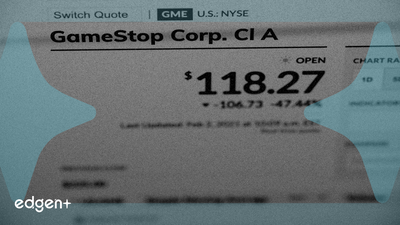Related News

Elevance Health Stock Falls 8.4% Despite Q3 Earnings Beat on Membership Concerns
## The Event in Detail **Elevance Health, Inc.** (ELV) announced strong financial results for the third quarter of 2025, which paradoxically preceded a significant stock decline. The company reported an adjusted earnings per share (EPS) of $6.03, a figure that surpassed the Zacks Consensus Estimate by a substantial 21.1%. Financially, the company demonstrated considerable strength. Total operating revenues reached $42.2 billion, a 10% increase year-over-year, beating the consensus estimate of $41.5 billion. A key contributor to this performance was the **Carelon** segment, which saw its revenues climb by 33% year-over-year to $18.3 billion, also exceeding estimates. This growth was supported by strong performance in the company's Medicare Advantage business. However, the headline earnings did not prevent a negative market reaction. The company's stock has fallen 8.4% since the earnings report, indicating investor concern over other key performance indicators. The primary driver of this bearish sentiment is a 0.9% year-over-year decrease in total medical membership, attributed to a decline in Medicaid membership. ## Market Implications The market's adverse reaction highlights a focus on subscriber trends over headline profitability. The drop in Medicaid enrollment is a critical concern for investors, as it signals a potential weakening in a major revenue stream. While the growth in Medicare Advantage is a positive counterpoint, it has not been sufficient to assuage fears about the sustainability of the company's overall membership base. This situation suggests that the market is pricing in the risk associated with member retention and the rising costs associated with the remaining members. Earlier in the year, Elevance reported a benefit expense ratio of 86.4%, an increase of 80 basis points year-over-year, primarily driven by higher cost trends within its Medicaid business. ## Broader Context The membership losses at **Elevance** are not occurring in a vacuum. They are reflective of a broader industry trend involving the redetermination of Medicaid eligibility, which has been in effect since March 2023. National data shows that Medicaid and CHIP enrollment has decreased by 9.3% since this redetermination process began. This systematic unwinding of pandemic-era enrollment policies is forcing major insurers to adapt to a shrinking Medicaid market. The challenge for **Elevance Health** and its competitors is to manage the decline in their Medicaid portfolios while simultaneously capitalizing on growth areas like Medicare Advantage. The market's response to ELV's earnings indicates that simply beating EPS and revenue estimates is not enough; investors are now scrutinizing the underlying health of the business, measured by membership growth and the cost of care delivery.

Zelenskyy to Review U.S. Peace Proposal, Plans Consultation with Trump Amid Reports of Territorial Concessions
## Executive Summary Ukrainian President Volodymyr Zelenskyy has officially received a draft peace plan from the United States aimed at ending the conflict with Russia. The proposal is set for discussion with former U.S. President Donald Trump, a move interpreted by observers as an attempt to build bipartisan consensus ahead of potential changes in U.S. foreign policy. Market sentiment remains highly uncertain, as reports suggest the plan may include politically sensitive terms, such as territorial concessions by Ukraine, which could have significant ramifications for geopolitical stability and commodity markets. ## The Event in Detail In a statement released on Telegram, the Ukrainian President's Office confirmed the receipt of a draft plan from the U.S. designed to "intensify diplomacy." President Zelenskyy stated his agreement to work on the proposal to achieve a "just end to the war." A key development is the planned consultation between **President Zelenskyy** and **Donald Trump** to discuss the plan's fundamental principles. This follows a meeting between Zelenskyy and U.S. military officials, including U.S. Army Secretary Dan Driscoll. However, reports from multiple news outlets, including **Al Jazeera**, suggest the plan is not without controversy. It has been reported that the proposal entails **Kyiv** ceding territory and some weaponry in exchange for peace. This detail represents a significant potential shift from Ukraine's long-standing public position of not surrendering any land. Russia has acknowledged that contacts with the U.S. are ongoing but stated there are no new developments to announce. ## Market Implications The primary market impact revolves around geopolitical risk and its direct effect on commodity prices. A viable path to peace could significantly reduce the risk premium currently priced into key global commodities. * **Energy Markets:** The conflict has been a major driver of volatility in European natural gas and global crude oil prices. A de-escalation could lead to a sharp reduction in energy prices as supply disruption fears wane. * **Agricultural Markets:** Russia and Ukraine are major global suppliers of wheat, corn, and sunflower oil. A resolution that restores safe passage and export capacity from the Black Sea region would likely put downward pressure on global food prices. Conversely, if the proposed terms, particularly territorial concessions, lead to internal political instability within Ukraine or are rejected, it could prolong the conflict and market uncertainty. ## Expert Commentary Market analysts observe that while any diplomatic initiative is a positive signal, the reported details are fraught with execution risk. The concept of ceding territory is a significant hurdle that has derailed previous peace efforts. The inclusion of **Donald Trump** in the consultation process is viewed as a pragmatic move to "de-risk" the peace plan from the electoral cycle in the United States. Commentators suggest this strategy aims to ensure the plan's durability regardless of the outcome of the upcoming U.S. presidential election. The market is expected to react with high sensitivity to any official statements from Kyiv, Moscow, or Washington regarding the tangible terms of the proposal. ## Broader Context This development comes as the war continues with high attrition and as Ukraine urgently calls on allies for greater military support. The nation's reliance on Western aid makes it sensitive to shifts in U.S. and European policy. The proposal to cede land, if accurate, marks a stark contrast to Ukraine's maximalist position of restoring its 1991 borders. This shift in tone from the U.S. side may reflect a calculated move to break the diplomatic stalemate ahead of a U.S. election year, where foreign policy and aid commitments are likely to become major points of debate. The outcome of these discussions will serve as a critical indicator of the future direction of the conflict and the stability of Eastern Europe.

Commercial Metals (CMC) Stock Declines 6% Amid Conflicting Valuation Signals
## Executive Summary Commercial Metals Company (**CMC**) experienced a notable 6.0% decline in its stock price over the past week, prompting a closer examination of its market valuation. The company currently presents a conflicted investment profile. On one hand, a Discounted Cash Flow (DCF) analysis indicates that the stock may be undervalued by as much as 25.8%. On the other, metrics such as the price-to-earnings (P/E) ratio suggest it could be overvalued, leading to significant uncertainty among investors regarding the stock's true worth. ## The Event in Detail The stock's recent performance shows a 6.0% weekly drop and a 1.7% monthly fall, with the current price fluctuating around $57-$58. This is situated within a 52-week range of $37.92 to $64.53. The core of the current debate lies in the conflicting messages from different valuation methodologies. The DCF model, which forecasts future cash flows and discounts them to arrive at a present value, points to a significant 25.8% undervaluation. This suggests that the market may not be fully appreciating the company's long-term earnings potential. Conversely, a high P/E ratio often signals that a stock's price is high relative to its current earnings, a potential indicator of overvaluation. ## Market Implications The divergence between the DCF and P/E ratio analyses creates a challenging scenario for investors. The 25.8% undervaluation suggested by the DCF model could attract value investors looking for a long-term entry point, viewing the recent price drop as a buying opportunity. However, the cautionary signal from the P/E ratio may deter more conservative or short-term-focused investors, who might interpret the high multiple as a sign of inflated value and potential for further downside. This tension could lead to increased trading volatility as the market struggles to find a consensus on the stock's fair value. ## Expert Commentary Market analysts highlight the classic conflict between future-looking and present-looking valuation metrics. A DCF analysis is inherently forward-looking, relying on projections of a company's financial performance. The finding that **CMC** is 25.8% undervalued suggests that, based on its projected ability to generate cash, its intrinsic value is significantly higher than its current stock price. In contrast, the P/E ratio is a simpler metric based on current earnings. A high P/E can indicate either that investors expect high future growth or that the stock is simply expensive. The discrepancy forces a critical question: is the market underestimating **CMC**'s future, or is the stock overpriced based on its present performance? ## Broader Context This type of valuation conflict is not uncommon, particularly in cyclical industries like metals and construction, where future earnings can be volatile and difficult to predict. The strategic expansions undertaken by Commercial Metals are a key factor in its DCF valuation, as these are expected to generate future growth. However, market sentiment can be slow to price in the benefits of long-term strategy, especially when short-term indicators are mixed. This case underscores the importance for investors of using a range of analytical tools and understanding the assumptions and limitations inherent in each model before making a decision.
